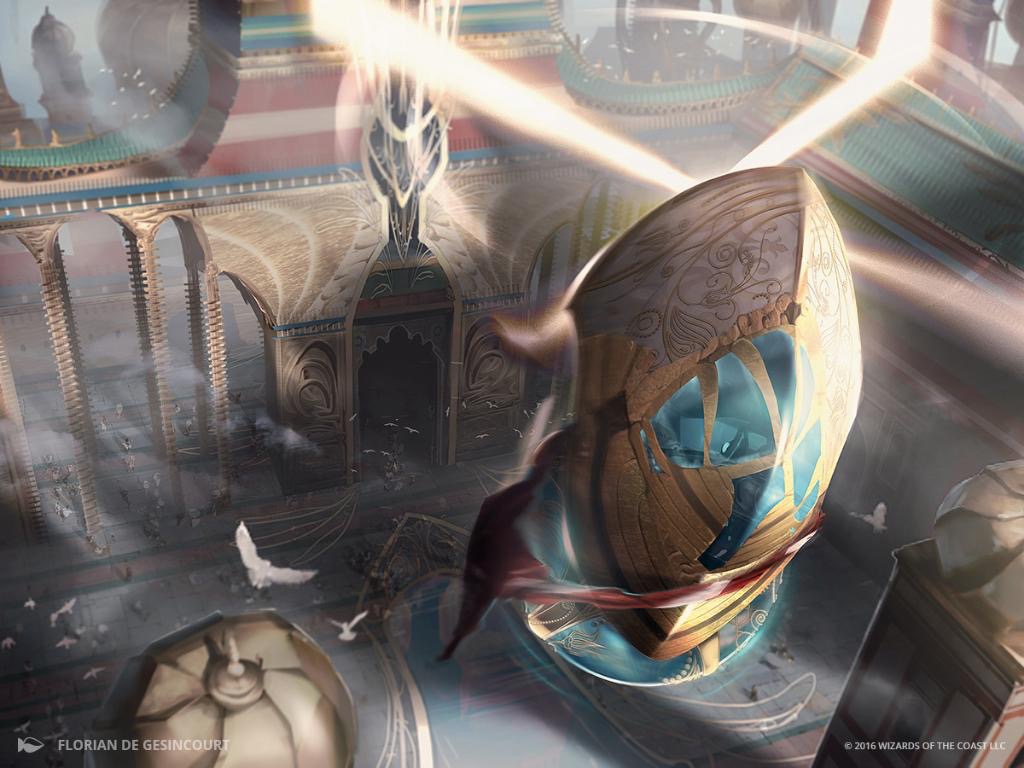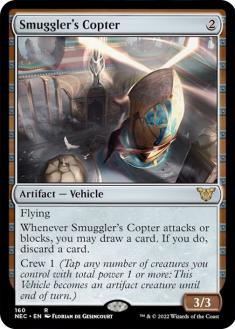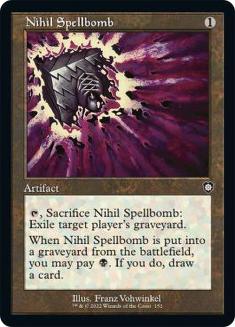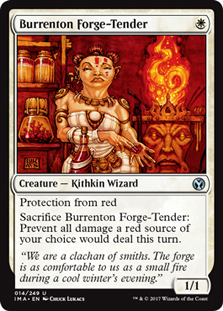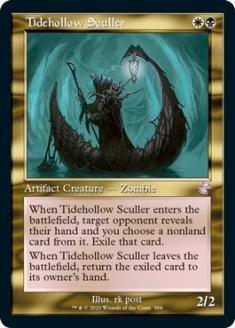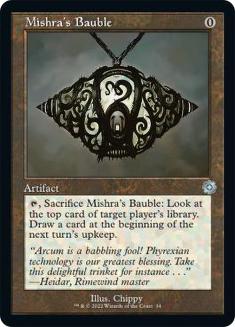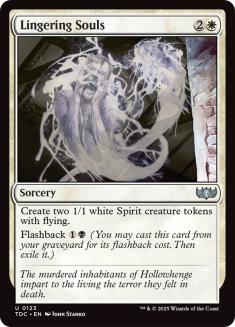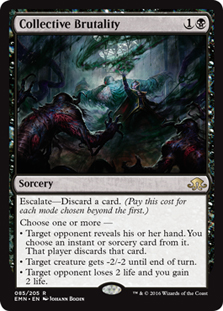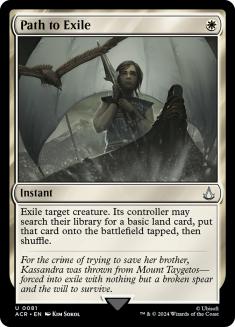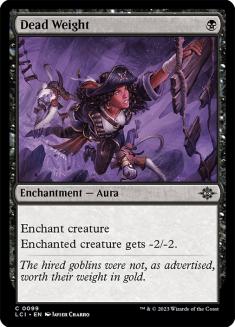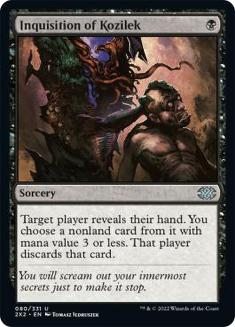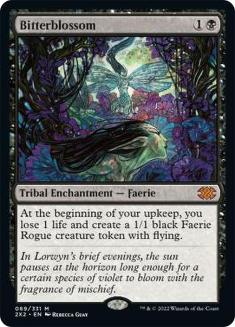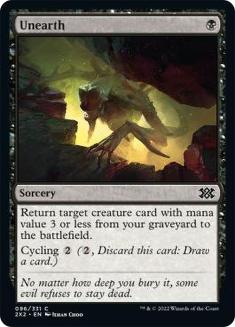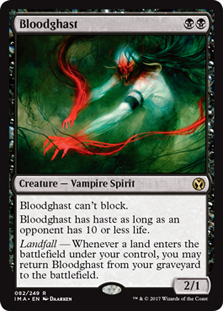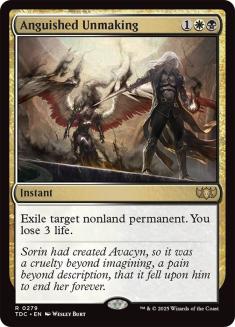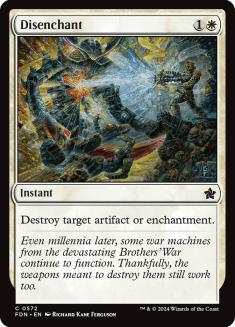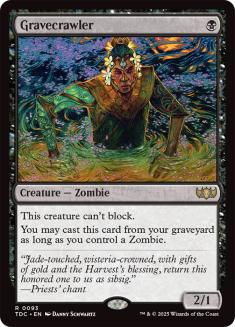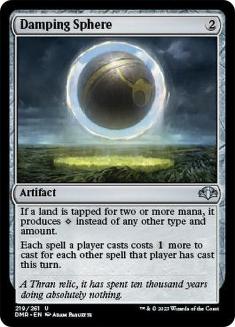For most of my career, I’ve been the kind of player who tunes one of the known decks to my liking and runs with it. I never fancied myself a great deckbuilder, and generally took a don’t screw it up mentality into my deck choices. Every now and then I’d find a deck I thought was underrated or overlooked but those cases were the exceptions, not the rule.
But something has changed for me in the last two years. I think it was the experience tuning Izzet Phoenix and watching a deck that I popularized ascend to the pinnacle of the Modern metagame, generate banning discussions, and ultimately contribute to Faithless Looting’s exodus from the format. It was a first for me in my career and I have to say it was intoxicating.
Creatures (13)
Lands (13)
Spells (34)

I’ve had some minor successes with rogue decks, but nothing close to that scale, and since then I’ve been more confident in my ability to look for potential in underutilized cards and find the right supporting cast to make them shine.
And with Modern in flux since the arrival of Ikoria: Lair of Behemoths, I have shied away from the Lurrus Burns and Yorion Urza decks that are no doubt powerful but uninspired. Modern has absorbed the impact from the powerful creature cycle because its card pool is large enough to support many decks of similar power level that utilize companions, while Standard and Pioneer have seen a scant few decks that use them privileged above the rest.
My search for novel companion decks began last week with Lurrus Death and Taxes. The Selesnya list I featured in my article last week proved promising in testing, but an idea from my chat while streaming it has led my Modern testing in a different direction. The result is a powerful new archetype for Modern, and there are plenty of lessons from the testing process, so here’s the story of how I came to Lurrus Orzhov Copter.
Brewing in Modern Post-Companions
Death and Taxes can play any secondary color it wants given the wealth of fixing available in Modern, and many members of my chat were curious about black as the support color, mainly for Tidehollow Sculler. I was intrigued, but ultimately stuck by Noble Hierarch as the most valuable addition from any second color. However, when the combination of Tidehollow Sculler and Carrion Feeder was raised, I thought about the potential for a Taxes shell that incorporated a sacrifice theme.
I was brought to Taxes out of the desire to sidestep the attrition fights that Lurrus of the Dream-Den pushes you to play, and sacrifice synergy would add another angle of attack in long games. Lurrus would help you assemble the synergies through disruption and push the deck to be creature-heavy enough to leverage Thalia, Guardian of Thraben well.
During the brainstorming stage of brewing, it became clear that paring this deck down to a lean 60 would prove a difficult task. There were simply too many solid pieces to fit everything I wanted. The major tension was between Thalia and Lingering Souls. The former is a key element to the tempo plan of Taxes decks, while Lingering Souls is one of the most powerful enablers for sacrifice decks and also a great threat against removal-heavy Lurrus decks like Jund and Four-Color Control.
Ultimately, I decided that making the blend between the two strategies work wasn’t going to happen, and I should lean into the sacrifice deck. The result was a list that was reminiscent of the Orzhov Copter deck Julien Berteaux piloted to some success a few years ago, updated with some of the powerful cards printed since then. Here was my first list:
Creatures (22)
- 4 Carrion Feeder
- 2 Dark Confidant
- 3 Tidehollow Sculler
- 3 Bloodghast
- 4 Gravecrawler
- 2 Blood Artist
- 4 Stitcher's Supplier
Lands (20)
Spells (18)

When I set out, my goal was to sidestep the attrition game everyone was playing, and I ended up leaning headfirst into it with this list, but that’s not a bad thing. This deck generates a ton of card advantage, but does so with permanents so you don’t lose tempo. In fact, if you put Bloodghasts into your graveyard with Stitcher’s Supplier, you gain tempo while accumulating extra resources.
Despite looking like a creature-heavy aggro deck, this deck functions more like a disruption-heavy midrange deck, using its bevy of discard and removal spells to answer its opponent’s threats while leaving their removal to answer a horde of tokens and recursive threats that it is ill-equipped to do. Lurrus has forced decks to play plenty of spot removal so they can answer early threats that could run away with a game if left unchecked while still having some left for the follow up Cat that will do the same, and this deck seeks to take advantage of that by presenting the opponent with creatures that just won’t die.
Even Smuggler’s Copter, which on paper dies to both Lightning Bolt and Fatal Push, is only vulnerable when you crew it, so you can use your discard to clear the way for it to attack, at which point discarding your recursive threats quickly snowballs into an avalanche of card advantage.
Despite cutting the Taxes element of the deck, this list was tight on space, as evidenced by the various three-ofs. I cut slightly away from the sacrifice theme to fit in some Dark Confidants, which are a great follow-up to discard spells and help you against graveyard hate. I also wanted some Blood Artists to give the deck reach and break through stalled battlefields, which can be tough for recursive threats because they tend to be smaller than the creatures on the other side of the battlefield.
First Impressions
The deck performed very well in its first session, but there were some clear issues. The curve was glutted at two and both Dark Confidant and Blood Artist were unnecessary. The deck has so much natural card advantage that as long as you contain what your opponent is doing you don’t need any extra help to take over the game.
Second, my initial list was short on ways to get your graveyard payoffs into the graveyard. Smuggler’s Copter and Stitcher’s Supplier could only do so much. Collective Brutality is versatile enough to maindeck, especially when Lurrus Burn is popular, so a couple made their way over from the sideboard. This change killed two birds with one stone since I also wanted more removal, and Collective Brutality conveniently answers Lurrus. There are few better feelings than using Brutality to kill a Lurrus and strip your opponent of their Unearth, taking them immediately from supreme confidence to abject ruin. (Trust me, I knew a few things about that transition.)
Last, I made some significant errors in the manabase. This deck is quite mana-hungry since its threats keep coming back, so a 22nd land came in. Wanting to keep my lands around also created tension with Silent Clearing. I was often punished for sacrificing them, and the pain from drawing multiples was a significant downside, so I trimmed down to two copies. I was also bitten by having Mutavault over a colored source several times, but it was also effective when activated, especially when I needed a creature to crew Smuggler’s Copter or a Zombie to recast Gravecrawler, so I added a second copy of Urborg, Tomb of Yawgmoth to make Mutavault less punishing and mitigate damage from the Horizon lands.
These changes resulted in the following list:
Creatures (18)
Lands (21)
Spells (21)

The maindeck Nihil Spellbomb is a concession to the importance of graveyard interaction in Modern, helping against opposing Lurrus decks; Uro, Titan of Nature’s Wrath; Mystic Sanctuary; and of course Dredge. It’s also a way for Lurrus to gain easy card advantage, so the opportunity cost is low while the upside is game-changing.
The sideboard had open space with Collective Brutality moving to the maindeck and my decision to cut Stony Silence since it’s largely ineffective in a post-Mox Opal world and has serious anti-synergy with Smuggler’s Copter and Nihil Spellbomb. Adding Anguished Unmaking was a nod to the fact that this deck can struggle to put enough power onto the battlefield to pressure planeswalkers against Bant Snow, though it answers any problematic permanent, from Rest in Peace to Chalice of the Void.
And lastly, Burrenton Forge-Tender is my nod to both the popularity of Burn and the potential blowouts from Anger of the Gods. It plays excellently with Lurrus, letting you use it aggressively only to recur it on Turn 4 to protect your companion or your life total.
No Sacred Cows
This list was a significant improvement on the first, and playing with it was exciting, challenging, and rewarding all at the same time. However, there was one card that continued to underperform: Tidehollow Sculler. Everyone is prepared to answer two-toughness creatures right now so it rarely stays on the battlefield, and even if it does, it often doesn’t get into combat because you don’t want to trade it away. It may have been one of the cards that drew me to this deck in the first place, but it wouldn’t make the final cut.
The last tweak I wanted to make was to the removal suite. Fatal Push and Collective Brutality are both great, but pairing them leaves you vulnerable to Uro and Yorion. Uro is particularly problematic because it’s the best way for decks like Bant Snow and Yorion Temur Uroza to gain traction, letting them turn the corner and simply race your recursive threats rather than try to answer them ad infinitum. Some Paths needed to make it into the maindeck.
Those changes led to the following final list:
Creatures (16)
Lands (21)
Spells (23)

I added a sixth discard spell to compensate for the loss of Tidehollow Sculler, and now this list has the same number of discard spells (eight) as the original. The two freed sideboard slots were filled by a second copy of Disenchant, out of respect to both Hardened Scales and Chalice of the Void, and a singleton Dead Weight. An en vogue choice due to its synergy with Lurrus, I chose it to help combat creature-heavy decks like Humans that can prove problematic since they can trump your recursive threats on the battlefield.
Through testing, the deck’s core synergies proved powerful enough that I mostly wanted more interaction to stop the cards that went over the top of me. I’d recommend this list moving forward unless your metagame is replete with big mana decks like Mono-Green Tron and Amulet Titan.
What About Mishra’s Bauble?
Mishra’s Bauble has become a hot commodity because of its obvious synergy with Lurrus, and my not playing the card is among the most-asked questions I get about the deck. You can certainly play the card if you want to, but I don’t think it’s needed here. This deck is trying to be more proactive than something like Jund, and it doesn’t play a lot of instants like that deck or Burn, so the slowtrip mechanic is a much bigger downside here.
Also, with so much going on here, casting Lurrus as early as possible isn’t a priority. It’s a very powerful card and easy to fit into the deck, but it’s not the deck’s Plan A and you don’t need to bend the deck to its whims. This deck plays a similar gameplan to Lurrus decks, recurring threats and casting disruptive spells to prepare for an attrition game, all the while applying enough pressure to make it hard for the opponent to effectively do the same, but the fact that it’s not reliant on Lurrus to execute that gameplan is a strength, not a weakness.
Your opponent is free to leave in a bunch of spot removal to handle Lurrus, but it’s not going to do much else against Gravecrawler and company, and at that point you can use Lurrus as a way to re-buy a Smuggler’s Copter and that will be enough to win the game. If they skimp on spot removal to prepare for your first wave, then an unanswered Lurrus will take over the game with or without Mishra’s Bauble.
There are definitely games where having Bauble would help, and I’ll be testing the card in later versions, but I hardly think it’s the slam-dunk addition that many have told me it is.
Sideboard Guide
VS Lurrus Burn
Out:
In:
There are three elements to balance here: keeping your life total high, pressuring them to take away as many draw steps as possible, and answering Lurrus. You have plenty of removal for Lurrus, and balancing the other two is about timing your own Lurrus correctly. You want to cast it right before they can untap to kill you, so you have maximum time to develop your own battlefield but they are still forced to point a burn spell at your companion. Of course, if you have the chance to cast it when they don’t have an answer or you can protect it with Forge-Tender, then just go right ahead.
VS Jund Midrange
Out:
In:
I essentially treat this like the Jund mirror, which means accepting the fact that all your resources will trade in the early-game and topdecking discard spells after that is terrible, so they all come out for extra interaction. Don’t get too aggressive here unless they have a card advantage-generating threat you can’t answer. Bloodghast will always be there in the end.
VS Hardened Scales
Out:
In:
This is a scary matchup because they don’t plan to remove your recursive threats and instead trump them on the battlefield. The synergies here are powerful and you don’t have time to mess around, so my plan is to sideboard in as much interaction as possible while cutting some recursive threats. Lingering Souls stays in over Bloodghast since it can check Inkmoth Nexus.
VS Yorion Temur Uroza
Out:
In:
The ground-based recursive threats can get trumped in this matchup, and you don’t need to be operating on every cylinder in this matchup as long as you contain their key threats: Emry, Lurker of the Loch; Uro, Titan of Nature’s Wrath; and Urza, Lord High Artificer. If one of them sticks, then going to the air with Lingering Souls and Bitterblossom is your best bet, so all of those stay in.
VS Bant Snow
Out:
In:
Much like Temur Uroza, you need to contain Uro, but they don’t have the other threats, so you can cut more removal and stay threat-dense. The tension here is between Supreme Verdict and planeswalkers since you want to hold back against the former and extend to stop the latter. Most of your threats are good against Verdict, so I err on the side of making them have it so they can’t land an early Jace, the Mind Sculptor or Teferi, Hero of Dominaria.
VS Amulet Titan
Out:
In:
Your removal here is good for keeping Dryad of the Ilysian Grove and friends off the battlefield, but you can’t have much or you won’t have the closing speed to end the game before they draw an answer to Damping Sphere for the necessary lands to cast Primeval Titan though it. Normally I’d cut all my Lingering Souls before any Bloodghasts because they’re slower but sometimes you need flyers to close through Zombie tokens from Field of the Dead so I’m cutting one of each.
VS Five-Color Humans
Out:
In:
Like Hardened Scales, Humans can trump your recursive threats in combat, so all the removal you have comes in and your weakest disruption comes out. Mantis Rider is critical for them since it plays both offense and defense, making it even easier for them to contain your recursive threats. Prioritize killing it and get in damage when you can. Your goal is to work the game to a point where you’re ahead in the race so they can’t alpha strike, and even when they hold back you can make productive attacks where they block your Gravecrawlers and Bloodghasts, only to see you recur them in your next main phase.
Often this pattern leads to a close race where a good draw either way can swing it, but sometimes you kill all their relevant creatures and your Bloodghasts start trading.

